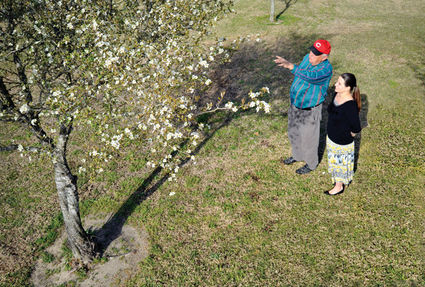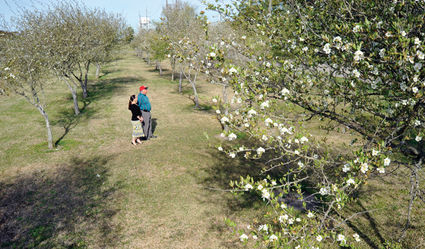Mayhaws flourish in BC grove
Last updated 3/24/2010 at Noon
While spring is heralding its entry, and the landscape awakens with color, sound and sunlight, many people will be returning to some of their favorite rituals. The newness of the season can be a magical time of discovery, pleasing to the eyes and the palette.
But there’s something special to discover in this part of the U.S. Something that can be even tastier than ice cream or a snow cone.
It drives people to dig deep in their closets for just the right bucket and pair of gloves. It compels people to rifle through their canning supplies and clear out plots in their yard for this fresh find.
Yes, people are eager to put these juicy perennials in their mouth and their yard.
The months of April and May, beacon this tradition of mayhaw gathering, which draws families all over the Southeast Texas region.
The gnarled bark on the sprawling mayhaw groves on Bridge City Chamber of Commerce property at 150 West Roundbunch Road, is the telltale sign one of the area’s most popular mayhaw orchards has been to hell and back. But short of scaling dangerous swamp marsh or partaking of a sparse supply along the lakeshore, this is one of the largest locally abundant mayhaw crops in Orange County.
“The trees have proved their unique resistance, having weathered nine tropical storms and hurricanes,” said John Harrington, the local horticulturist who donated the now flourishing trees in 1995.
“The most recent hurricane, Ike, with its salt water deluge, proved the trees could handle even the Gulf seawater,” he added.
The orchard was designed to give future generations a place to collect the spoiled seedlings, which have already fallen to the ground, in order to sprout new seedlings for individuals to plant.
People can also pick berries from about 90 trees planted on the chamber property.
Following is the five-step method to sprouting your own seedlings: Pick up the rotting mayhaw already fallen from the tree; Place mayhaws in a blender and blend on slowest speed for 30 seconds; Quickly transfer the pulp, seeds and water into a plastic bucket, taking great care not to expose the seeds to sunlight Stir well daily for 10 days until the fermentation process is done Retrieve the seed from the bottom of the bucket and plant immediately. Again, take great care in not exposing the seeds to sunlight.
The USDA recommends planting these perennial trees in well-drained, slightly acid soils. The trees have the potential to grow 30-foot canopies in diameter after a 20-year period. When planting an orchard, trees thrive when planted 15 to 20 feet in a row and 18 to 20 feet between rows.
There are several explanations on how the mayhaw got its name.
The most widely accepted is ‘May’ for the month it is fully bearing fruit and ‘Haw’ for its membership in the Hawthorne genus.
According to the USDA, the Cretaegus Opaca Mayhaw, also called, riverflat mayhaw, western mayhaw or apple haw, is predominantly native to Texas, Louisiana, Arkansas, Mississippi and Alabama.
Hawthornes in general are very resilient specie, with an estimated 600 in its family. But through a one-year period of hybridization and grafting experiments, Harrington was able to create a rootstock resistant to the mayhaw’s worst enemies. These include salt water, cretaegus and cedar-apple rusts.
While a nice blend of Mayhaw jelly might be considered good for the soul, many medicinal uses for the tree have been used over many centuries. Naturopaths in India and China have used mayhaw variants to treat digestive disorders and heart disease.
“The population of our world is getting so dense that all of the agricultural land is getting taken up by people, cemeteries, homes,” Harrington said. “So we wanted plants to live on marginal soil.”
The mayhaw’s beauty has often been deceiving.
Their white spiraling blooms have been described as fragrant, yet only in the sense that they stink good, according to Harrington.
“It’s an indigenous plant whose blooms smell like rotten meat,” he said. It typically draws the carrion fly, which is a fly often found feeding on dung, he added. “Honey bees only work them for the pollen.”
Popular uses for the fruit of the mayhaw, include preserves, juice, relish, jelly, syrup, wine and tea.
The taste could easily be described as a mix of apple, peach and apricot. Although just as the same perfume can smell different on 10 people, so the variations of flavor combinations for mayhaws from the same tree can be endless.
That goes for color too.
Mayhaws have been known to sport red, maroon and even yellow variants, depending on what grafting has taken place.
While there are many common dietary uses for mayhaw, Harrington recommends a refreshing blend of Mayhaw Leaf Tea, which may be served hot or cold. Simply dry the leaves in a food processor until they become “crispy critters.” Loosely grind the leaves and store in plastic bags in a deep freeze. Place the loose leaves in steeping hot water and stir occasionally. Strain the resulting tea and then dilute to the color of regular, domestic tea, and it is ready to serve at the preferred temperature.
“If people are interested, right now people can come pick for free,” said Angela Beck, chamber director. She added if there’s more of a demand later on, then the chamber would consider charging.
For information on location and best times to pick mayhaws, contact the chamber office at (409) 735-5671 or online at http://www.bridgecitytex.com.
















Reader Comments(0)